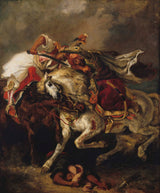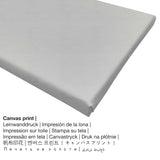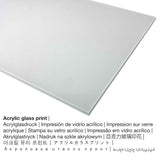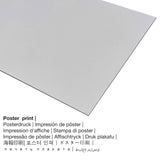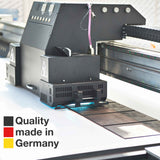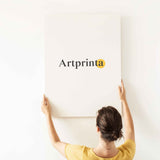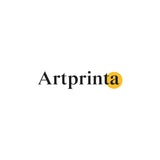Eugène Delacroix, 1835 - Vita vya Giaour na Pasha - chapa nzuri ya sanaa
Kodi ni pamoja. Usafirishaji umehesabiwa katika Checkout.
Utoaji wa bidhaa
Hii zaidi ya 180 Kito cha miaka mingi kilichorwa na kiume mchoraji Eugène Delacroix. The original has the following size: Height: 73 cm, Width: 61 cm. Oil painting was used by the French artist as the medium of the artwork. The original masterpiece has the following text as inscrption: Date and signature - Signed and dated lower right: "Eug 1835 Delacroix.". Siku hizi, mchoro huo ni wa mkusanyiko wa sanaa ya dijiti wa Petit Palais - Musée des Beaux-arts de la Ville de Paris, ambayo ni jumba la makumbusho la sanaa katika eneo la 8 la arrondissement. The sanaa ya kisasa kazi ya sanaa, ambayo ni sehemu ya Uwanja wa umma imejumuishwa kwa hisani ya Petit Palais Paris.Mstari wa mkopo wa kazi ya sanaa ni hii ifuatayo: . Juu ya hayo, alignment ni picha ya na uwiano wa picha wa 1: 1.2, ambayo ina maana kwamba urefu ni 20% mfupi kuliko upana. The painter Eugène Delacroix was an artist, whose art style can be classified as Romanticism. The European artist was born in the year 1798 huko Saint-Maurice, Val-de-Marne na alikufa akiwa na umri wa miaka 65 mnamo 1863 huko Paris.
Ni nyenzo gani unayopenda ya uchapishaji wa sanaa nzuri?
Kwa kila picha ya sanaa tunatoa vifaa na saizi tofauti. Chagua kati ya chaguo zifuatazo za bidhaa sasa ili kulinganisha mapendeleo yako kwa ukubwa na nyenzo:
- Chapisha kwenye glasi ya akriliki: The acrylic glass print, often described as a fine art print on plexiglass, makes the original into lovely décor. Further, the acrylic art print makes a good alternative option to canvas or aluminium dibond art prints. Your favorite work of art will be manufactured with the help of modern UV printing technology. The major upside of an acrylic glass art print is that contrasts plus smaller image details will be recognizeable due to the precise tonal gradation.
- Mchapishaji wa dibond ya Alumini: An Aluminium Dibond print is a material with a true depth. The bright & white parts of the work of art shimmer with a silk gloss, however without glow. Colors are luminous in the highest definition, fine details are crisp, and there’s a matte appearance that you can literally feel.
- Chapisho la bango (nyenzo za turubai): Our poster print is a UV printed canvas paper with a fine surface finish. Please bear in mind, that depending on the absolute size of the canvas poster print we add a white margin 2-6cm around the print, which facilitates the framing.
- Uchapishaji wa turubai: The printed canvas material mounted on a wood stretcher frame. Hanging a canvas print: A canvas print has the great advantage of being relatively low in weight, which implies that it is easy and straightforward to hang up the Canvas print without additional wall-mounts. A canvas print is suited for all types of walls.
Legal note: We do our best in order to describe our products as exact as we can and to display them visually in our shop. Still, the pigments of the printing material and the imprint can diverge somehwat from the representation on the device's screen. Depending on your settings of your screen and the nature of the surface, colors may not be printed as exactly as the digital version on this website. In view of the fact that all art reproductions are printed and processed manually, there might as well be minor differences in the exact position and the size of the motif.
Maelezo ya kipengee kilichopangwa
| Uainishaji wa makala: | uchapishaji mzuri wa sanaa |
| Uzazi: | uzazi wa kidijitali |
| Mbinu ya uzalishaji: | Uchapishaji wa moja kwa moja wa UV (uchapishaji wa dijiti) |
| Asili: | Uzalishaji wa Ujerumani |
| Aina ya hisa: | uzalishaji kwa mahitaji |
| Matumizi yaliyokusudiwa ya bidhaa: | muundo wa nyumba, nyumba ya sanaa ya ukuta |
| Mwelekeo: | mpangilio wa picha |
| Uwiano wa picha: | 1: 1.2 |
| Tafsiri ya uwiano wa picha: | urefu ni 20% mfupi kuliko upana |
| Vitambaa vya bidhaa vinavyopatikana: | chapa ya chuma (dibond ya alumini), chapa ya glasi ya akriliki (yenye mipako halisi ya glasi), chapa ya bango (karatasi ya turubai), chapa ya turubai |
| Chaguzi za ukubwa wa kuchapisha turubai (turubai kwenye fremu ya machela): | 50x60cm - 20x24", 100x120cm - 39x47", 150x180cm - 59x71" |
| Uchapishaji wa glasi ya akriliki (iliyo na mipako halisi ya glasi) anuwai za saizi: | 50x60cm - 20x24", 100x120cm - 39x47", 150x180cm - 59x71" |
| Chaguzi za kuchapisha bango (karatasi ya turubai): | 50x60cm - 20x24", 100x120cm - 39x47" |
| Chapa ya aluminium (nyenzo za dibond ya alumini): | 50x60cm - 20x24", 100x120cm - 39x47" |
| Muafaka wa picha: | bila sura |
Maelezo ya kazi ya sanaa iliyopangwa
| Kichwa cha kipande cha sanaa: | "The Combat of the Giaour and the Pasha" |
| Uainishaji wa kazi za sanaa: | uchoraji |
| Neno la jumla: | sanaa ya kisasa |
| kipindi: | 19th karne |
| Mwaka wa uumbaji: | 1835 |
| Umri wa kazi ya sanaa: | zaidi ya miaka 180 |
| Mchoro wa kati asilia: | Uchoraji wa mafuta |
| Ukubwa asili (mchoro): | Urefu: 73 cm, Upana: 61 cm |
| Saini kwenye mchoro: | Date and signature - Signed and dated lower right: "Eug 1835 Delacroix." |
| Makumbusho / eneo: | Petit Palais - Musée des Beaux-arts de la Ville de Paris |
| Mahali pa makumbusho: | Paris, Ufaransa |
| Tovuti ya makumbusho: | Petit Palais - Musée des Beaux-arts de la Ville de Paris |
| Leseni ya kazi ya sanaa: | Uwanja wa umma |
| Kwa hisani ya: | Petit Palais Paris |
Taarifa za msanii
| Jina la msanii: | Eugène Delacroix |
| Jinsia: | kiume |
| Raia wa msanii: | Kifaransa |
| Taaluma: | mchoraji |
| Nchi ya msanii: | Ufaransa |
| Uainishaji: | msanii wa kisasa |
| Mitindo ya sanaa: | Upendo |
| Umri wa kifo: | miaka 65 |
| Mwaka wa kuzaliwa: | 1798 |
| Mji wa Nyumbani: | Saint-Maurice, Val-de-Marne |
| Alikufa: | 1863 |
| Alikufa katika (mahali): | Paris |
Maandishi haya ni haki miliki na yanalindwa na hakimiliki ©, Artprinta.com
Original artwork information from Petit Palais - Musée des Beaux-arts de la Ville de Paris website (© Copyright - Petit Palais - Musée des Beaux-arts de la Ville de Paris - Petit Palais - Musée des Beaux-arts de la Ville de Paris)
Inspired by oriental Lord Byron poem, the painting represents the decisive battle between the Giaour, mounted on a black horse, and Hassan Pasha, on his white horse. The Giaour, standing over his saddle, hard with a wild smile cloth covering the chest of the Pasha to reach the heart with acute blade of his sword. The pasha, precariously balanced on his horse, holding in his right hand a dagger, trying to push her attacker on the other hand. The ferocity of the struggle is also expressed in the attitude of the horse, the black horse biting the chest white horse, already wounded in the thigh. The latter seems to be reluctant to walk on the dead body of a Muslim lying on the ground. For Delacroix, the subject is mostly an excuse to portray a melee of great intensity, where humans and animals are closely associated.
Figure guardian of Romanticism, Delacroix was introduced to the East by reading Byron works. He discovers the realities during a trip to Morocco in 1832. His style of painting is deeply marked by the experience. This painting was inspired by a passage from Byron oriental tales published in 1814 under the title "The Giaour, a fragment of a turkish tale". The story chronicles the thwarted loves of a Venetian, the Giaour (term for an infidel to Muslims) and a slave, Leila, belonging to the harem of Hassan, military chief of a Turkish province. Leila, who missed the loyalty she had the Pasha Hassan was thrown into the sea. Her lover, the Giaour, the revenge by killing Hassan.
Hassan Pasha (literary character); The Giaour (literary character)
Scene, Single combat, Knight, Pasha, Turkish, Turban, Horse, Saber, Dead, Orientalism

